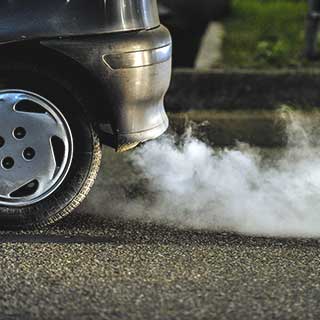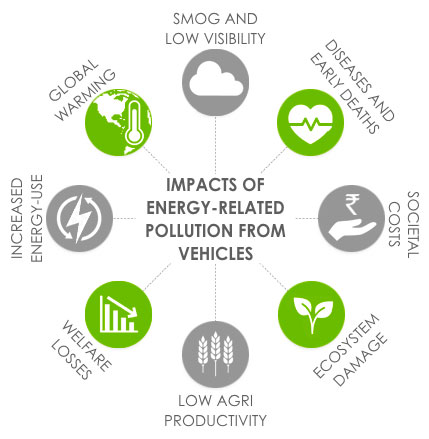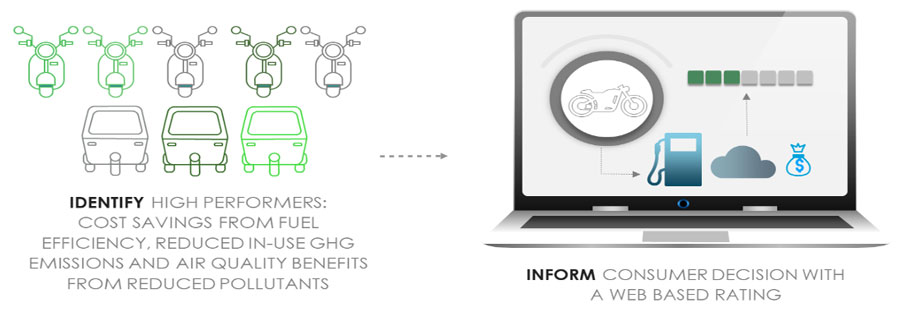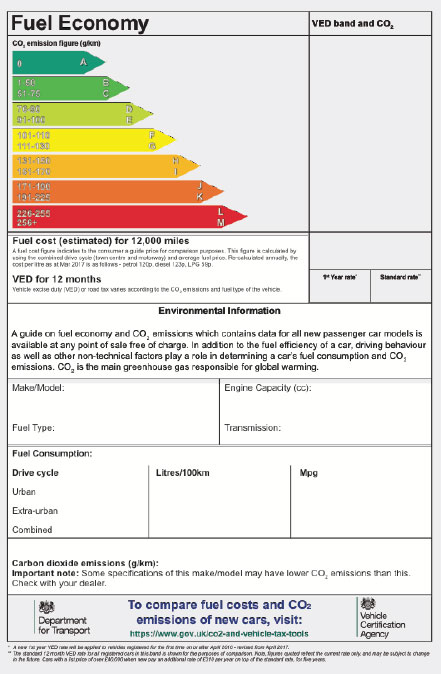Green Vehicle Rating: Reshaping Consumer Knowledge on Environmental Performance of Vehicles

World Health Organisation (WHO) deems clean air as a human right, but in India many people don’t have access to clean air due to severe air pollution. As of 2019, 14 out of 20 most polluted cities worldwide were in India as per the WHO Ambient Air Quality Database. Among other sectors, road transport is a significant contributor to greenhouse gases (GHG) emissions and criteria pollutants such as NOx, SOx, CO, HC, PM2.5, etc. in these cities. Moreover, vehicular transport continues to be an oil guzzler in India and consequently, has a significant carbon footprint.

Overtime vehicle demand is expected to increase, especially for the budget-friendly mode of transport, i.e. two-wheelers in India’s case. Additionally, post Covid-19, preference for personal mode of transport over public transport will increase. Therefore, the problem of air pollution will aggravate further with time.
The GHG emissions and criteria pollutants have high external costs both in terms of health and environment, as indicated in Figure 1. It is to be borne in mind that the impact and its cost cascades through the consumers, markets and the government.
Shift from Emission Intensive Mobility to Zero-Emission Mobility
There is no silver bullet to solve the issues of air pollution. One of the most effective ways to nudge the transport sector towards an efficient and cleaner future is to influence consumer purchase favouring more fuel-efficient and less polluting vehicle models. While purchasing vehicles, consumer primarily focuses on “kitna deti hai?,” i.e. mileage and upfront cost. External costs of pollutants and greenhouse gases emitted by motor vehicles are not valued by consumers for several reasons, such as lack of adequate information in the public domain and difficulty comprehending emission data. There is a need to bring a paradigm shift in consumer behaviour from “kitna deti hai?” to “Kitna leti hai”.
Bringing a change in consumer behaviour starts with reliable and explicit information-impact of criteria pollutants and CO2 emissions on health and environment-as they purchase vehicles. This will facilitate the gradual shift of customer preference from current emission-intensive Internal Combustion Engine (ICE) vehicles to low emission ICE-vehicles and eventually to zero-emission vehicles which essentially have the electric technology. Further, this will contribute to the government’s broader objective of promoting e-mobility and contributing to the Sustainable Development Goals.
Development of GVR – Stepping stone for a Drive towards Clean Transport
In this domain, as a first-time effort in India, AEEE has pioneered the Green Vehicle Rating (GVR), the country’s only vehicle rating system based on environmental performance. This type of rating system exists in several countries such as Next Green Car in the UK, Greenercars in the US, and Ecoscore in Belgium.
GVR serves as a consumer information tool that identifies high to low performing vehicle models, in two and three-wheeler categories, in terms of the negative impacts of GHG emissions and criteria pollutants released from tailpipes of top-selling models. Along with a comparative analysis of vehicle models, the GVR shows the external costs of pollution from vehicle exhausts – GHGs and criteria pollutants.


Figure 2: Benefits of Green Vehicle Rating for consumers, industry and the government (AEEE, 2018)
By making this information available to consumers, the goal is to reshape their knowledge on the real cost of owning a vehicle, beyond retail price-tags and self-reported mileage data supplied by auto dealers, commonly used as criteria during vehicle purchase in India. In phase I, GVR evaluated the tailpipe emissions of 20 two-wheeler models and 2 three-wheeler models. Under the phase II, both internal combustion and electric variants of two and three-wheelers will be covered. As the purpose of the initiative is to sensitise consumers about the environmental impact of vehicle use, a dedicated web-portal (http://aeee.in/green-vehicle-rating/) has been created which allows consumers and other stakeholders to check the GVR of a vehicle model (currently covering 2 and 3 wheelers) and also reference to the methodology, data and assumptions used to rate the vehicles.
GVR programme is a vital steppingstone to bring a range of regulatory reforms as briefly described below:
- As GVR reveals the impact of different models on human health and the environment, the policymakers can leverage these insights to introduce a “feebate” system.
- It can also be used by the concerned authority to introduce a star labelling programme.
- GVR can be extended to develop a dedicated Corporate Average Fuel Economy (CAFÉ) standards for two and three-wheelers.
- Damage cost method used in GVR although nascent but fundamental to understand the cost worthiness of regulatory investment in vehicle air pollution.
Supports Policy and Regulatory Initiatives to Curb Vehicular Emissions
The Government of India is undertaking various initiatives to address the menace of vehicular emissions. The Bureau of Energy Efficiency (BEE), the nodal agency on energy efficiency, has set CAFÉ standard for passenger cars and is in the process of introducing a fuel economy labelling programme for the passenger car segment. As BEE is undertaking both labelling and CAFÉ standards for passenger cars, GVR would potentially complement the existing system to develop CAFÉ standards and labelling for two-wheeler and three-wheeler segments by providing information about both fuel and environmental economy of the vehicles. BEE is also planning to extend the Standards and Labelling programme for Electric vehicles.
The government is also mulling to introduce hologram-based coloured stickers on vehicles to indicate the nature of the fuel used. This will help identify vehicles running on polluting fuels. In this context, the result of GVR can be used to make these stickers more comprehensive and grade vehicles based on their environmental performance. There are instances of such labelling programmes around the world. Some examples of such labels are shown in the figure below:

 Figure 3: Fuel economy labels in the US (Top) and UK (bottom)
Figure 3: Fuel economy labels in the US (Top) and UK (bottom)
NITI Aayog in partnership with the Rocky Mountain Institute (RMI) has carried out an exploratory study on the potential for the design and implementation of a national feebate policy to drive vehicle efficiency in India. Results of GVR could help policymakers in implementing the feebate system based on fuel type. Higher taxes are imposed on more polluting vehicle models in such a system, and the revenue collected can be used to provide incentives to cleaner technologies and fund R&D activities. GVR can act as a catalyst in pushing the agenda for clean mobility by nudging the consumer towards adopting cleaner variants of vehicle models, encouraging automakers to develop more efficient models, thereby supporting the policymakers in reducing vehicular emissions.
Written by Bhawna Tyagi, Senior Research Associate, Energy Data Services




